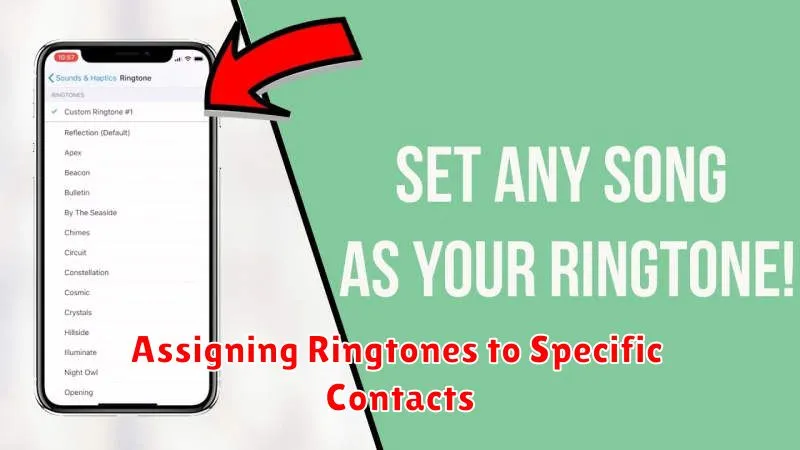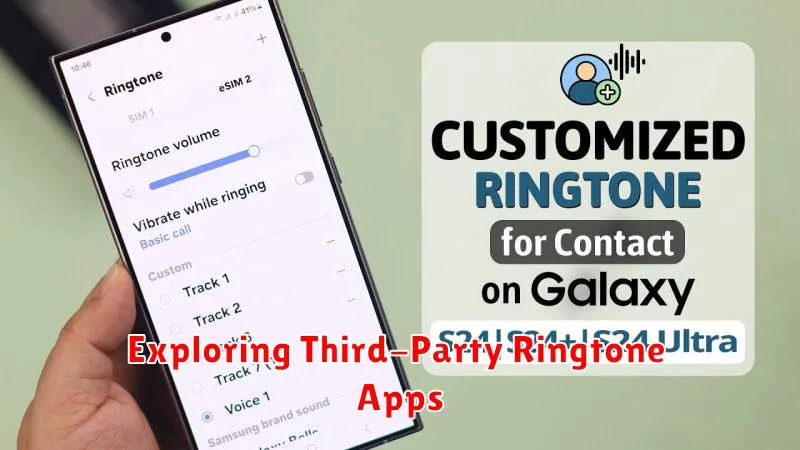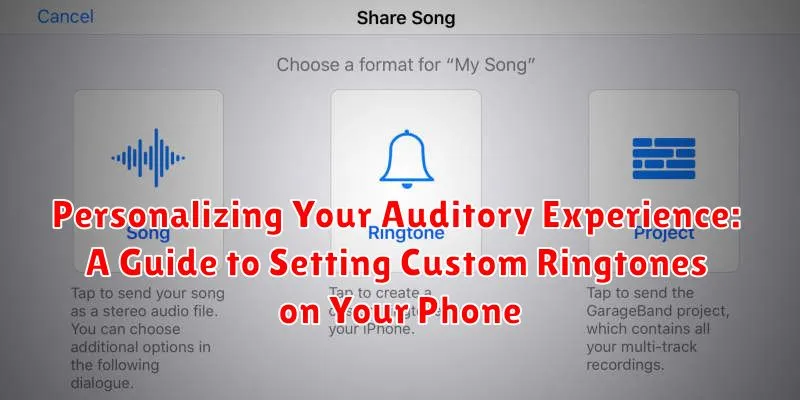In today’s interconnected world, our phones serve as essential tools for communication, information access, and personal expression. One often overlooked aspect of personalization is the ability to customize ringtones. Setting custom ringtones allows you to instantly identify callers, differentiate between notifications, and truly make your auditory experience your own. This guide will walk you through the process of setting custom ringtones on your phone, empowering you to break free from the default sounds and embrace a more personalized auditory experience.
Whether you desire a catchy tune, a beloved song, or a specific sound effect, setting personalized ringtones offers a level of customization that enhances your daily interaction with your device. From navigating the settings to understanding different file formats and exploring various customization options, this guide will provide you with the knowledge to curate a unique auditory experience tailored to your individual preferences. Learn how to set custom ringtones for specific contacts, differentiate message alerts, and create a truly personalized soundscape on your phone.
Understanding Ringtone Formats
Before diving into setting a custom ringtone, it’s important to understand the compatible file formats your phone supports. Common ringtone formats include MP3, M4R (primarily for iPhones), and OGG. Knowing the correct format is crucial for successful implementation.
MP3 is a widely supported audio format known for its good balance between file size and audio quality. Most phones readily recognize and play MP3 ringtones. M4R, on the other hand, is a format specifically designed for Apple devices. While similar to MP3, it’s optimized for iOS. OGG is another format gaining popularity due to its open-source nature and efficient compression.
Check your phone’s specifications to determine the supported ringtone formats. This information can typically be found in the user manual or on the manufacturer’s website. Using the correct format ensures your chosen ringtone plays correctly and avoids potential compatibility issues.
Choosing Your Perfect Ringtone
Selecting the right ringtone is a crucial step in personalizing your phone. Consider factors like your personality, environment, and lifestyle.
Think about the image you want to project. A professional setting might benefit from a classic or subtle tone, while a more social environment allows for something expressive and fun. Do you prefer something upbeat and energetic, or calming and melodic?
Your environment also plays a role. A loud ringtone is essential in noisy areas, while a softer tone suffices in quieter spaces. Consider the frequency of your calls. A long, complex ringtone might become irritating if you receive numerous calls daily.
Finally, explore different genres. Experiment with various sounds, from classical music and jazz to pop and rock. Don’t be afraid to try something unique that truly reflects your individual style.
Downloading Ringtones from Online Platforms
Numerous online platforms offer a wide selection of ringtones for download. These platforms can be a great resource for finding unique and personalized sounds. When selecting a platform, it’s important to consider factors such as the legality and safety of the downloads.
Some platforms offer free ringtones, while others require a purchase or subscription. Always ensure the website is reputable to avoid potential malware or copyright infringement issues. Look for platforms with clear terms of service and user reviews.
Downloaded ringtones often come in various file formats. Pay attention to the compatible file types your phone supports. Common formats include MP3, M4R, and OGG. Some websites might offer conversion tools if your device requires a specific format.
Transferring Ringtones to Your Phone
Once you have your desired ringtone file, the next step is transferring it to your phone. The method you use will depend on your phone’s operating system (OS) and available connectivity options.
For Android devices, you can typically connect your phone to your computer via a USB cable. After establishing a connection, your phone should appear as a storage device on your computer. Simply locate the ringtone file and copy it to the “Ringtones” folder on your phone’s internal storage or SD card.
iPhone users can utilize iTunes (or Finder on newer macOS versions) to transfer ringtones. After syncing your phone, drag and drop the ringtone file into the “Tones” section of your device within iTunes/Finder. The ringtone will then be available on your iPhone.
Alternatively, some phones support transferring files via Bluetooth or cloud services like Google Drive or Dropbox. Upload the ringtone file to your chosen platform and then download it directly to your phone.
Using Built-in Ringtone Makers
Many modern smartphones include built-in ringtone makers, allowing you to create personalized ringtones without needing additional apps or downloads. These tools often provide a simple interface for editing audio files already on your device. You can typically select a song or sound clip, and then trim it down to the desired length for your ringtone.
Some built-in ringtone makers offer more advanced features, such as the ability to add fade-in and fade-out effects or even layer multiple audio tracks. These options give you greater creative control over your ringtone composition. Be aware that the specific features available will vary depending on your phone’s operating system and manufacturer.
To access your phone’s built-in ringtone maker, look within your sound settings or music player app. The exact location may differ between devices, but it’s usually easily found. Once located, you can explore the various options and begin crafting your unique ringtone.
Setting Your Custom Ringtone
Once you have your desired ringtone on your phone, the process of setting it is generally straightforward. Navigate to your phone’s Settings app. The location of the ringtone settings may vary slightly depending on your phone’s operating system and manufacturer.
Typically, you’ll find a Sound or Sound & Vibration section within the Settings. Within this section, look for an option labeled Ringtone, Phone Ringtone, or something similar. Tapping this option will present you with a list of available ringtones.
Your newly transferred custom ringtone should appear in this list. Simply select the ringtone to set it as your default incoming call sound. Some devices might offer a preview option, allowing you to listen to the ringtone before confirming your selection.
Assigning Ringtones to Specific Contacts

A key feature of custom ringtones is the ability to assign unique tones to individual contacts. This allows you to immediately identify who’s calling without looking at your phone’s screen. The process varies slightly depending on your phone’s operating system and version.
Generally, you’ll begin by opening your Contacts app. Select the desired contact, then look for an Edit or Options button. Within the contact’s details, there should be a Ringtone option. Tap on it, and a list of available ringtones, including your custom ones, will appear. Choose the desired ringtone and save your changes.
This personalized touch can be incredibly useful for distinguishing between important calls, such as family members or work colleagues, from general calls.
Troubleshooting Ringtone Issues
Occasionally, you might encounter problems setting or hearing your custom ringtone. Here’s a guide to troubleshooting common issues:
Ringtone Not Playing: If your ringtone doesn’t play, ensure the volume isn’t muted and is set at an audible level. Verify the ringtone file is not corrupted and is in a supported format. Restarting your phone can sometimes resolve temporary software glitches affecting ringtone playback.
Incorrect Ringtone Playing: Double-check you’ve selected the correct ringtone file during the setup process. Sometimes, a previously selected ringtone might be playing instead of the new one. Review your phone’s sound settings to ensure the correct tone is assigned.
Ringtone Works for Calls but Not Notifications: Your phone may have separate settings for call ringtones and notification sounds. Verify that you’ve set your custom tone for both if desired. Some apps also have individual notification settings that might override your phone’s general settings.
Specific Contact Ringtone Not Working: Ensure the ringtone is correctly assigned to the contact in your contacts app. Check for any conflicting settings within the contact details that might override the custom ringtone assignment.
Exploring Third-Party Ringtone Apps

Numerous third-party apps offer extensive ringtone libraries and creation tools. These apps often provide a wider selection of ringtones than pre-installed options or basic online platforms.
Benefits of using a third-party ringtone app include access to a larger catalog of sounds, advanced ringtone editing features, and often, a more user-friendly interface.
When choosing a third-party app, consider factors like the size and quality of the ringtone library, the app’s user interface, the presence of ads, and any associated costs. Some apps offer free downloads with ads, while others may require a subscription or one-time purchase for premium content.
Installing a third-party app typically involves searching for the app in your device’s app store, downloading it, and granting necessary permissions. Always ensure you download apps from reputable sources to minimize security risks.
Once installed, these apps usually provide a straightforward process for selecting, downloading, and setting ringtones, often integrating seamlessly with your phone’s system settings.

